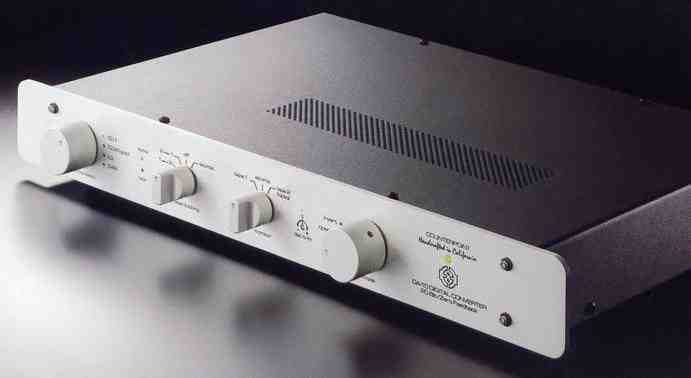|
|
[This article is based on a 02-1994 Stereophile review and product description at audio-database.com]
A main issue of this review deals with the modular DAC topology the Counterpoint DA-10 uses, and subjective differences amongst various modules. These modules allows the curious end-user to "play" with the D/A processor using DACs from myriad IC manufacturers.
As I've noted elsewhere in previous Gammaelectronics DAC articles, implementation of a DAC (chip) is more important than DAC architecture (Sigma-Delta, Bitstream, R2R). This observation is confirmed in the review below.
Digital/analog converter with interchangeable DAC cards. Available DAC cards: Ultra Analog D20400, Analog Devices AD1862, Burr-Brown PCM69, Crystal Semiconductor CS4328. Stock version shipped with AD DAC card. Electrical specifications: dependent on DAC card. Power consumption: 22W. Dimensions: 19” W by 2.75” H by 11” H (not including knobs). Weight: 4 lbs. Warranty: 3 years parts and labor. Price [late 1993]: $1695 plus DAC card (AD1862 card adds $259, UltraAnalog card adds $995, Crystal card adds $355, Burr card adds $595, ST-type optical input adds $200).
Approximate number of dealers: 120. Manufacturer: Counterpoint Electronic Systems, 2281 Las Palmas Drive, Carlsbad, CA 92009.
Someone interested in buying a digital/analog converter today must make tough choices. Not only are there several competing technologies to choose from—multi-bit, 1-bit, hybrid—but every converter also has its own musical signature. When some one buys a converter, they’re locked in to both the technology and the sound.

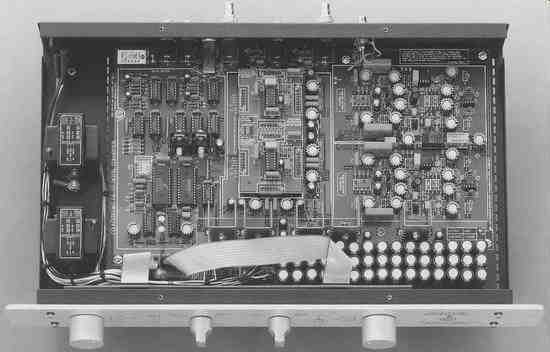
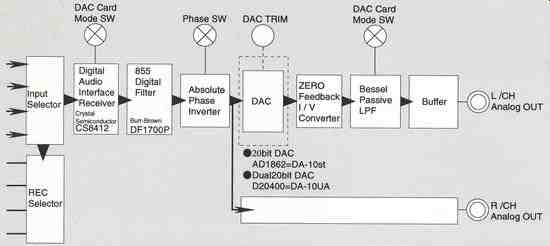
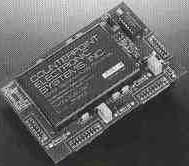
Counterpoint Electronics has addressed this dilemma with their DA-10 digital processor. The DA—10 is actually a “mainframe” into which different DAC boards can be installed. If a new, better DAC comes along, you can pop out the old one and put in the new. Or if you significantly change your playback system, you can choose a different DAC for the DA-10 that better complements the new system’s musical characteristics.
But is this a real advantage? Is a digital processor designed around just one DAC inherently better than one that accepts many DACs? And how much of a digital processor’s sound is determined by the DAC chip?
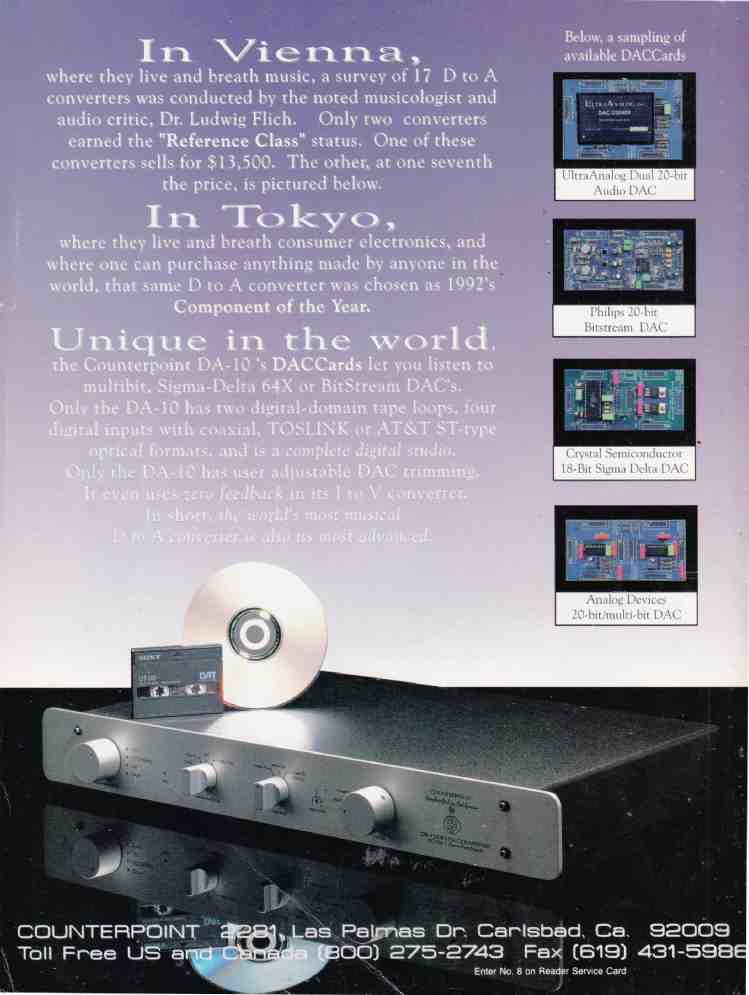
above: Full, rear-cover ad from Audio magazine (Sept 1993)
DESCRIPTION
The DA-10 is housed in a sturdy, slim- line chassis with a very attractive front panel. At first glance, the DA-10 looks more like a preamplifier than a digital processor; the unit offers more features and controls than most digital converters. Four of these controls are rotary knobs, furthering the impression of a preamplifier: One knob selects between one of four digital inputs, another provides full digital-tape dubbing (1-2 and 2-1), the third is a digital-tape monitor switch, and the fourth is an invert/operate/mute control. LEDs indicate which input is selected and the position of the invert/operate/ mute switch. An additional LED illuminates if the data carries the SCMS flag, which will prevent digital recording of that signal. The front panel also has a feature that I believe is unique to the DA 10: a user—adjustable Most Significant Bit (MSB) trimmer. More on this later.
The rear panel has three electrical inputs on gold-plated BNC jacks. A fourth in put is an optional ($200) AT&T ST-type glass fiber jack. One of the digital tape-monitor inputs and outputs is on BNC jacks; the second digital tape loop has TosLink input and output. Analog out put is via a pair of single-ended RCA jacks. All the rear-panel hardware appeared to be of high quality. Moreover, the DA 10’s features, look, and “feel” were all more than I would expect for $1695.
Inside, the power supply features separate transformers for the analog and digital circuits and 17 regulation stages. Seven of the latter are three—pin types, which are then followed by ten discrete stages. All the supplies to the analog out put section and DAC are doubly regulated, first with three-pin regulators, then with discrete regulation stages. Power-supply filtering is unusual in that it’s provided by 44 470 electrolytic caps instead of a few larger caps. According to designer Michael Elliott, many small capacitors sound better than a few big caps. Overall, this is an impressive supply for a product of this price.
The S/PDIF input receiver is the now- ubiquitous Crystal CS8412 (“C” version). This feeds a Burr-Brown DF1700 8x-over- sampling digital filter, which is identical to the popular NPC SM5813 chip.
The DA-10’s unique feature is its switchable DAC cards, which allow the user to select from among many DACs simply by plugging in different DAC cards made by Counterpoint. The currently available DACs are the multi-bit UltraAnalog D20400 and Analog Devices AD1862, along with the Crystal CS4328 Delta-sigma part and the Burr- Brown PCM69 hybrid DAC (a combi nation of multi-bit and 1-bit). Additional DAC cards will be available as new DACs are introduced. The DAC cards are about 4.5” by 2.5”, except the Ultra-Analog D20400, which is somewhat bigger. The UltraAnalog card sells for $995, the Analog Devices board costs $259, the CS4328 is $355, and the PCM69 costs $595. I evaluated the UltraAnalog, Analog Devices, and Crystal boards.
To accommodate this wide range of DAC technology, the DAC card sends a signal back to the digital filter telling it to put out either 18- or 20-bit data, depending on the card installed. Further, because the Crystal CS4328 has its own on-chip digital filter, the 8x-oversampling DF1700 digital filter is bypassed when the Crystal board is installed.
Changing DAC cards is easy. The board unplugs from connectors and the new board pops into place. With the UltraAnalog DAC card, the user must plug in a two-conductor cable from the motherboard to the DAC card (engaging a de-glitch circuit). A pair of toggle switches on the motherboard must also be thrown when changing to certain DAC cards.
I mentioned earlier that the DA-10 has a user-adjustable front-panel MSB trimmer. What does an MSB trimmer do? In most multi-bit DACs, the transition between the digital levels 111111111111— 1111 and the next-higher binary number 00000000000000002 occurs at the zero crossing point, also called “bipolar zero.” If the value of the most significant bit (the leading “1” in our first binary number) isn’t exactly the value of the 15 lower bits plus one, non-linearity will result. In practice, it’s very difficult to achieve close enough accuracy between steps to avoid a discontinuity at the zero crossing transition. Consequently, DAC manufacturers provide a means of adjusting the value of the MSB so that it’s exactly one quantization step greater than the value of the 15 lower bits (in a 16-bit DAC). Although digital-processor manufacturers usually set the MSB at the factory by hand, the optimum MSB adjustment changes with temperature and age. A perfectly set MSB trimmer may be misadjusted when the unit is fully warmed up, or a year later after the circuit has drifted.
[The Philips SAA7323 and SAA7350 Bitstream DACs are no longer available as Counterpoint cards. I heard them at a CES and thought they sounded horrible. The popular Burr-Brown PCM63 isn’t available for the DA-10; Michael Elliott thought the AD 1862 was a better-sounding DAC.]
Counterpoint has addressed this problem with the front-panel MSB trimmer. Although it requires some test equipment to correctly set the trimmer, Counterpoint suggests it be adjusted by ear (they liken this to setting phono cartridge VTA). Note that, of the currently available DACs for the DA-10, only the Analog Devices AD1862 DACs need trimming. One-bit DACs work on an entirely different principle and need no adjustment. The UltraAnalog multi- bit DAC has been factory-calibrated by hand-soldering metal-film resistors into the resistor ladder network so that trimming is unnecessary. The UltraAnalog DAC will maintain its virtually perfect linearity over time. You can tell which DACs need trimming and which don’t simply by looking at the front panel: an LED above the trimmer illuminates when the DA-10 is fitted with a DAC card that needs trimming.
[Rather than use a simple other binary 16-bit encoding where the lowest analog voltage level is equivalent to 0000000000000000 (ie, 0), and the highest to 1111111111111111 (ie, 65,535), the CD system uses “twos-complement” coding. This is so that the coding operates symmetrically about the midpoint of the maximum ± voltage swing. With offset binary, where the signal is described by only positive digital numbers, any kind of processing in the digital domain can easily result in an increased offset and thus a loss of accuracy. An additional advantage of twos-complement encoding is that it minimizes the circuit complexity for mathematical signal manipulation. In 16-bit “twos- complement” coding, the most negative voltage before clipping is represented by 1000000000000000, the highest positive voltage by 0111111111111111. The MSB therefore acts as a “sign bit”: when set to 1, it indicates that the encoded voltage is negative.
See “Industry Update” in Vol.16 No.6, p.57, for a report on how the DACs are hand-calibrated.]
Another feature unique to the DT-10 is its discrete current—to—voltage (I/V) converter. Most processors use an op amp for the I/V stage, but designer Michael Elliott wanted to remove opamps from the signal path as far as possible. The I/V stage also has no feedback. Only the AD 1862 DAC card uses this discrete I/V converter: 1-bit DACs inherently have a voltage output and don’t require I/V conversion. Further, the UltraAnalog converter has an integral op-amp I/V converter which also doesn’t require the DA-10’s stage. A manual switch on the pcb engages the I/V converter when the AD1862 DAC is installed. The analog output stage is a discrete, direct-coupled unity-gain buffer that incorporates a high-speed video amplifier. The DC-servo’d circuit uses no feedback. All the transistors have small heatsinks mounted to them. Dc-emphasis is passive, switched in by a relay. The output filter is a passive third-order Bessel type. A muting relay prevents noise from appearing at the analog output jacks when the processor isn’t locked to incoming data.
SYSTEM
Most of the DA-10’s auditioning was done with the Audio Research LS5 preamplifier (and the ARC BL2 Balanced Line Driver) and the new ARC VT-150 all-tube monoblock power amps. I also used the Krell KSA-300S power amp. Loudspeakers were Thiel CS3.6es connected by AudioQuest Sterling cable, CD transports were the PS Audio Lambda and a Mark Levinson No.3 1. Digital interconnects included Audio- Quest Optical Pro II (ST-type), Aural Symphonies Digital Standard coaxial, and a new impedance-matched digital interconnect called DataStream Reference, from a company called Illuminati. Analog interconnects were Expressive Technologies IC-i and AudioQuest Diamond. Power to the system (except the power amplifiers) was conditioned by a Tice Power Block and Titan. The acoustically designed listening room is treated with ASC Tower Traps.
I’ll start by describing the sound of the three DAC cards relative to each other, then give an overview of those sonic qualities of the DA-10 that were common to all the DAC cards. I’ll also compare the DA-10 with the Crystal CS4328 card installed to the $895 Meridian 263 processor, which also uses the CS4328 DAC. Finally, I’ll put the DA-10 up against the PS Audio UltraLink, with both the AD1862 and UltraAnalog DAC cards in the DA-10.
PICK A CARD, ANY CARD
The Crystal 1-bit DAC card held no surprises: the sound was similar to what I’ve heard from other processors using the chip. The CS4328 has a distinctive signature: soft bass, limited dynamics (particularly in the bass), lack of extension, but a beautiful, almost ethereal, midrange and treble.
The DA-10 with the CS4328 had some appealing qualities. The treble was nicely balanced and very clean. In fact, the DA-10 has the best-sounding treble of any converter using the CS4328 I’ve heard to date. The top end was open, airy, and integrated with the music. Moreover, the midrange and treble were free from grain and hash. Strings weren’t overlaid with the gritty texture often heard from digital. Similarly, cymbals had a nice shimmer and detailed character rather than sounding like bursts of undifferentiated white noise.
Soundstaging was also excellent. The DA-10 with the C54328 DAC board spread out before me an open, spacious, and very transparent soundstage—the presentation had a real sense of depth and space. Instrumental images were surrounded by an impression of air and bloom rather than sounding like card board cutouts. Moreover, the soundstage was transparent and crystal-clear. The ability to hear deep into the soundstage was first-rate, and the lack of opacity gave the music a sense of realism I greatly enjoyed.
The overall presentation with the CS4328 was smooth, laid-back, and musically accessible. The sound didn’t offend, yet it didn’t have the dynamic impact and gripping immediacy of many competing converters.
Switching to the AD1862 DAC card was like changing processors entirely. The AD1862 was incisive, tight, and highly focused compared to the C54328. The AD1862’s bass differed vastly from the Crystal DAC’s. Through the AD 1862, kick drum took on a depth and power only hinted at by the Crystal—the AD1862 gave some real weight and impact. I could hear the bass drum through the CS4328, but there was no power behind it. But with the AD 1862, this important instrument was powerful, better-defined, and sounded vastly more dynamic.
I was also struck by how different acoustic bass sounded through the two DACs. With the AD1862, John Patitucci’s bass on Kei Akagi’s Playroom (Blue-moon/Moo R2 79342) had a much wider dynamic expression. The AD 1862 portrayed the transient attack of fingers on strings—virtually missing from the C54328—infusing the music with greater life and enthusiasm. The CS4328 tended to mute the attack, thus blurring the distinctions between notes. Moreover, the AD1862’s “bouncier” bass quality made music much more rhythmically involving than the C54328. Bass guitar had more weight, power, and “purr,” which, when combined with the deeper extension and wider dynamics, produced a greater awareness of the music’s rhythmic characteristics.
The AD1862’s soundstage was also one area where many digital products fail: No matter what else they do right, a hashy treble makes music fatiguing and annoying (see SS’s SOTA Vanguard review in this issue). This quality was apparent with every DAC card, and greatly contributed to my favorable assessment of the DA-10.
The other quality that seemed intrinsic to the DA-10 was its remarkable sound— stage transparency: It removed the opaque veil between me and the music, and allowed a greater communication of the musical message. This hear-through clarity made instrumental images more tangible and palpable—more real-sounding. Image focus was superb by any mea sure, particularly with the AD 1862 DAC card. The DA-10’s soundstage was the antithesis of thick, murky, or congested, instead becoming a pristine picture- window view onto the music. Although the DA-10 tended to be a bit on the forward side of reality, it was not excessively so.
Bass performance tended to be good, though not superlative. Although the bass of the DA-10 (with the CS4328 card installed) was slightly better than the Meridian 263’s, I’ve heard deeper, tighter, and better—defined bass from other processors using the AD1862 and Ultra- Analog D20400 DACs (compared to the DA-10’s sound with those cards installed).
MEASUREMENTS
The DA-10’s unique ability to accept different DACs made measuring it more interesting and challenging. On one hand, it took nearly three times longer to measure. On the other, it was possible to look at the performance of different DACs with the same input receiver, filter, and output stage. Because presenting all the measurements on each DAC would consume too much space, I’ll show the measurements with the AD1862 (the DAC most likely to be installed in the DA-10), and comment on the performance of the other DAC cards when of interest.
The DA-10’s maximum output voltage when decoding a full-scale, 1kHz sinewave was 2.15V with the AD1862, 1.31V with the CS4328, and 3.39V with the UltraAnalog. Referenced to the standard 2V output, these levels are +0.63dB, —3.7dB, and +4.6dB respectively—a very large variance. When comparing the DAC cards, be sure to match levels with a voltmeter.
Output impedance—which is deter mined by the analog output stage not the DAC—measured a low 109 ohms across the audio band. I measured very low levels of DC at the analog outputs: 300 at the left channel, 400 uV at the right. The DA-10 doesn’t invert absolute polarity with any of the three DAC cards tested. It also had no trouble locking to the three standard sampling frequencies.
Frequency response (fig. 1) was predictably flat, but the DA-10’s dc-emphasis error was unusual in that it changed when the I/V converter stage, which is used only with the AD1862 DAC card, was switched into the circuit. The middle pair of traces is the DA-10’s dc-emphasis error with the AD 1862 card; the lower pair of traces is the dc-emphasis error with the CS4328 card. With the Ultra- Analog DAC, this error was identical to that measured with the CS4328, leading me to speculate that the I/V converter was somehow involved in this anomaly. I repeated these measurements several times on separate occasions, always obtaining identical results. The small positive error seen in the middle trace will cause a brighter, more forward presentation when playing pre-emphasized CDs. Although the error is small (less than half a dB), it spans more than three octaves of bandwidth—enough to be heard. The large negative dc-emphasis error shown in the bottom traces will be much more audible: the rolloff is greater than 1dB at 10kHz, and 15dB at 20kHz. This will cause a slight loss of air and openness when playing pre-emphasized discs, perhaps accompanied by a reduction in immediacy. (Very few CDs are pre-emphasized, however.
Interchannel crosstalk was low, the DA-10’s separation measuring 110dB at 1kHz, decreasing to 93dB at 20kHz. The crosstalk plot (fig.2) is dominated by power-supply noise at low frequencies. The peaks at 120Hz and 180Hz are power-supply noise intruding on the crosstalk measurement.
When I performed a spectral analysis on the DA-10’s output when decoding a —90dB, 1kHz dithered sinewave, I saw a huge (15dB) linearity error in one channel. Trimming the MSB with the front-panel control reduced this error to 12dB, still a severe error. Because the AD1862 DAC card also has MSB trimmers next to the DACs (which are not intended to be user-adjustable), I trimmed the bad channel for no error at —90dB. This produced a spectral analysis that looked better, but didn’t correct a fundamental problem with the DAC card. When I measured the DA-10’s linearity, it indeed had no error at —90dB, but did have what looked like missing code transitions (seen in the linearity plot of fig.3). Notice that at —90dB (the level at which I set the internal MSB trimmer) there’s no error, but clearly the right-channel DAC is severely misbehaving. No amount of MSB adjustment could correct this problem.

--- Fig.1 Counterpoint DA-10, frequency response with AD 1862 DAC (top); de-emphasis error with the AD1862 DAC (middle); de-emphasis error with the CS4328 DAC (bottom) (right channel dashed, 0.5dB/vertical div.).
---Fig.2 Counterpoint DA-10 with AD 1862 DAC, crosstalk (right—left dashed, 10dB/vertical div.).
---Fig.3 Counterpoint DA-10 with AD 1862 DAC, first sample, departure from linearity (right channel dashed, 2dB/vertical div.).
---Fig.4 Counterpoint DA-10 with AD 1862 DAC, second sample, departure from linearity before trimming (bottom); after trimming (top) (right channel dashed, 2dB/vertical div.).
[CD pre-emphasis is a high-frequency boost applied during recording or CD premastering. Pre-emphasized CDs carry a flag (in the Q—channel subcode) that tells the CD player or digital processor to switch in the de emphasis circuit that attenuates the treble and restores flat response. If the dc—emphasis circuit’s attenuation characteristics don’t match the pre—emphasis characteristics, dc—emphasis error results. Dc—emphasis error can bethought of as a frequency-response error when ever the processor is decoding pre-emphasized discs.
Emphasis was designed to improve the CD’s S/N ratio. By attenuating the treble after the DAC, DAC noise and artifacts are also attenuated. Very few discs have been pre-emphasized, particularly recently manufactured CDs, because engineers don’t like the reduction in headroom it leads to. Although emphasis can subject the signal to more electronics (on both the recording and playback sides), it can theoretically improve CD performance if properly implemented.]
Counterpoint sent me a new AD 1862 DAC card. Its linearity is shown in the bottom pair of traces in fig.4. The right channel’s linearity is excellent, but the left channel has nearly 4dB of positive error at 90dB—hardly good performance. This linearity problem can’t be corrected with the single front—panel MSB trimmer: if you set the left channel correctly, the right will be wrong. I then adjusted the left channel’s internal MSB trimmer on the AD1862 DAC card so it matched the right channel, producing the top pair of traces in fig.4. Note that the top traces have been off set by - and the lower traces by —6dB, sol could show them on the same graph.
In short, the AD1862 DAC card, as shipped, didn’t have its linearity matched between channels. Now we know that Counterpoint doesn’t cherry-pick review samples. Two minutes on an Audio Precision System 1—Counterpoint does use a large number of Audio Precision systems for its production-line QA and setup—could have adjusted the internal MSB trimmers so that the DACs would have behaved identically. The failure of two samples in a row to perform optimally—samples sent for review and measurement—raises questions about Counterpoint’s quality control which I assume they will address in their “Manufacturer’s Comment.” (below)
Incidentally, don’t try to adjust the internal MSB trimmers without proper test equipment; the range of the pot is so wide that severe mis-adjustment could easily occur. The front-panel MSB trimmer has a much smaller range; even if it’s set incorrectly, the absolute linearity error won’t be large.
Linearity measurements on the CS4328 and UltraAnalog DAC (not shown) indicated that these DACs’ low- level performances were swamped by noise. The positive error at low levels suggested that the implementation of these DACs in the DA-10 was perhaps less ideal than that of the AD 1862. Both the Crystal CS4328 and UltraAnalog D20400 have intrinsically better linearity and are quieter than I measured in the DA-10.
Fig.5 is the spectral analysis of a -90dB, dithered 1kHz sinewave with the AD 1862 DAC card (after I set the internal MSB trimmer). The DACs are now well-behaved, although there’s still a disturbing amount of power-supply noise intruding on the audio signal. This noise was there regardless of the DAC card installed, and remained even with different grounding arrangements.
The DA-10’s reproduction of a —90dB, undithered 1kHz sinewave is shown in fig.6 from the AD 1862 DAC, and in fig.7 from the UltraAnalog DAC. Note the much better wave shape and symmetry from the UltraAnalog DAC. The three transitions at this level (÷1, 0, —1) are more clearly delineated in fig.7. Note how the power—supply noise seen earlier shifts the zero crossing point above and below the DC line. In effect, the 1kHz sinewave is riding on the low-frequency noise component.
Fig.8 shows the DA-10’s excellent noise-modulation performance: the traces are tightly grouped, the noise level fairly low. This measurement was made on the best channel of the second sample which I hand-trimmed with the Audio Precision.
The DA-10 intermodulation spectrum is shown in fig.9 with the AD 1862, and in fig.10 with the UltraAnalog DAC. Although both spectra are quite clean and free from intermodulation components, the 1kHz difference component is completely nonexistent with the UltraAnalog DAC, but sticks up to —95dB with the AD 1862. There are also IM components at multiples of 1kHz in the AD 1862 FFT. The noise floor is also higher with the UltraAnalog DAC, even though it has a higher intrinsic signal/noise ratio than the AD 1862. This further supports my assumption made earlier that this particular implementation of the UltraAnalog DAC degrades its noise performance, and that the DA 10’s circuit works best with the AD1862.
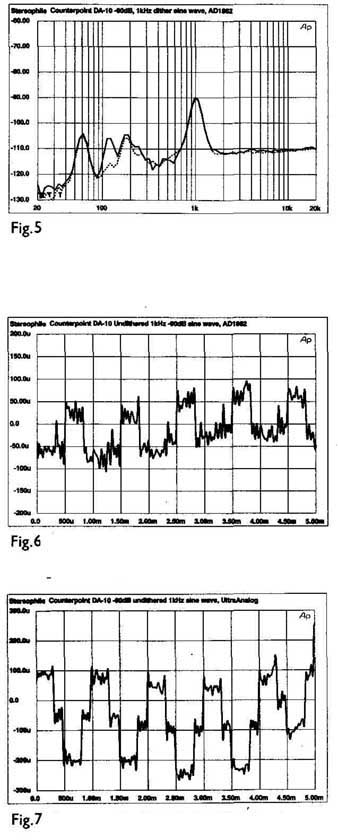
Fig.5 Counterpoint DA-10 with AD1862 DAC, second sample after trimming, spectrum of dithered 1kHz tone at —90.31 dBFS, with noise and spuriae (‘/ analysis, right channel dashed).
Fig.6 Counterpoint DA-10 with ADl862 DAC, waveform of undithered 1kHz sinewave at —90.31 dBFS.
Fig.7 Counterpoint DA-10 with UltraAnalog DAC, waveform of undithered 1-kHz sinewave at —90.31 dBFS.
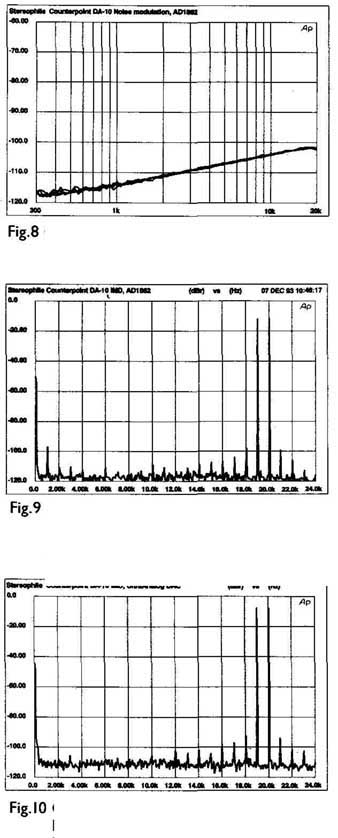
Fig.8 Counterpoint DA-10 with ADl862 DAC, noise modulation, —60 to —100dBFS (10dB/vertical div.).
Fig.9 Counterpoint DA-10 with AD 1862 DAC, HF intermodulation spectrum, DC— 22kHz, 9+20kHz at 0 dBFS (linear frequency scale. 20dB/vertical div.).
Fig.10 Counterpoint DA-10 with UltraAnalog DAC, HF intermodulation spectrum, DC—22kHz, 19+20 kHz at 0dBFS (linear frequency scale, 20dB/vertical div.).
Fig.11 is the 8x (352.8kHz) word-clock jitter when the DA-10 was driven by a full-scale, 1kHz sinewave. The signal-related jitter components are clearly apparent as spikes at odd multiples of 1kHz. The RMS level was a rather high 510 picoseconds, measured over a 400Hz-22kHz bandwidth. With a -90dB, 1kHz sinewave input, the jitter spectrum was much cleaner (flg.12), and the RMS level dropped to 450ps. Most processors have more, and higher-amplitude, signal—correlated jitter components at low signal levels. At —70dB (not shown), the spectrum looked very much like the full- scale spectrum shown in fig. 11. To look at how well the DA-10 attenuates (or passes) higher-frequency jitter, I drove it with a full-scale, 10kHz sinewave. The spectrum, shown in flg.13, shows a large spike of jitter energy at 10kHz. Over all, the DA-10’s jitter performance was less good than I have found to be possible with the CS8412 input receiver. (For comparison, see measurements of the PS Audio Reference Link’s jitter).
Overall, the DA-10 was somewhat disappointing on the test bench. I’ve come to expect better technical performance from digital processors in this price range. Moreover, after receiving two misbehaving AD1862 DAC cards, I’m concerned about Counterpoint’s quality control.
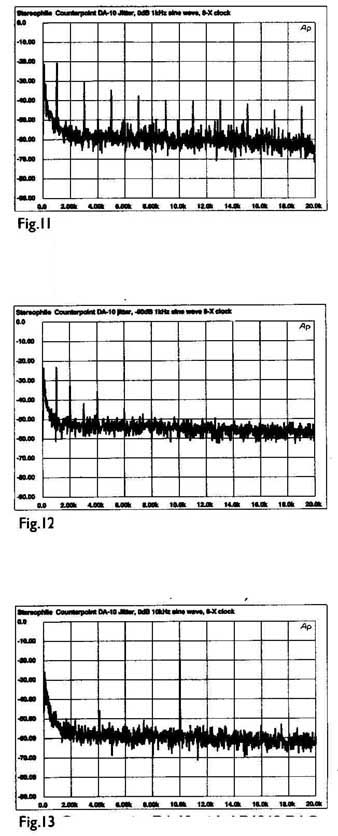
Fig.11. Counterpoint DA-10 with AD1862 DAC, word-clock jitter spectrum, DC-20kHz, when processing 1kHz sinewave at 0dBFS (linear frequency scale, 10dB/vertical div., 0dB = 1ns).
Fig.12 DA-10 with AD1862 DAC, word-clock jitter spectrum, DC-20kHz, when processing 1kHz sinewave at -90dBFS (linear frequency scale, 10dB/vertical div., 0dB = 1ns).
Fig.13 Counterpoint DA-10 with AD1862 DAC, word-clock jitter spectrum, DC-20kHz, when processing 10kHz sinewave at 0dBFS (linear frequency scale, 10dB/vertical div., 0dB = 1ns).
CONCLUSION
Overall, I liked the DA-10’s sound. It wasn’t a giant-killer, but it was competitive with the best comparably priced digital processors, nonetheless. With the CS4328 DAC card, the DA-10 sounded marginally better than the $895 Meridian 263. If you don’t need the DA-10’s features and interchangeable DAC ability, the 263 is a better value at less than half the DA-10’s price.
But with the AD 1862 DAC card, the DA-10 became a strong contender in the “Best DAC Under $2500” sweepstakes. Fitted with the AD 1862, the DA-10 had a grain-free treble, remarkably transparent soundstage, good portrayal of space, and an exciting immediacy and palpability. This was clearly the DA-10 at its best. Fortunately, the AD 1862 is also the least expensive of Counterpoint’s DAC cards.
Although the UltraAnalog DAC card had some appealing characteristics, the DA-10 didn’t seem to offer the best implementation of this excellent converter. The mids were a little hard, and the bass was warm and full rather than tight and well-defined. Considering that the UltraAnalog DAC card costs nearly four times as much as the AD 1862 card, the DA-10/UltraAnalog card is no bargain. A better implementation of the UltraAnalog DAC can be found in the $1995 PS Audio UltraLink, so far the best converter I’ve heard under $2000.
Although the DA-10 is nicely finished and has plenty of features, I was concerned about its poor bench performance. The power-supply noise in the audio signal (not heard through the loudspeakers), grossly misbehaving DAC (the first AD1862 sample), the MSB trimmer mis-adjustment of the second AD1862 sample, and large de emphasis error, suggest the DA-10 could be more carefully engineered. Although a product’s musical performance is always the bottom line of its worth, I prefer to see a product that sounds good and performs well technically.
We must also consider whether or not interchangeable DACs are a good idea. On the plus side, the ability to switch DACs allows the user to tailor the digital front-end’s sound to match his or her system and musical tastes. Conversely, the concept might not be ideal for achieving the best possible implementation of a particular DAC. It seemed that the DA-10 was designed to optimize the AD1862’s performance over those of the other DACs surveyed.
With that caveat, I can recommend the Counterpoint DA-10. Its excellent intrinsic sound quality and unique ability to accept different DACs make it competitive with the best processors in its price range.
COUNTERPOINT DA-10 [comment from MIKE ELLIOTT of Counterpoint]
Editor:
Many thanks the time the reviewer took to evaluate the DA-10 D/A converter. Most reviewers are satisfied with listening to the product and all its DAC Cards, then handing over the job of measurements to a test-bench jockey, but some reviewers have to do it all. And at Stereophile’s/TAS’s/Audio (magazine) wages, to boot!
His description of the sonics of the three DAC Cards he evaluated pretty much agrees with what others have heard (the Crystal Semiconductor CS4328 1-bit DAC is smooth and astoundingly transparent, great for choral and chamber ensembles; the Analog Device’s AD1862 20-bitter is a rock’n’roller’s dream DAC, possessing punch, rock-steady rhythm, and a tight, well-defined bottom end), but his stated preference for the AD 1862 over the UltraAnalog definitely places him in the minority. In terms of sales, most buyers want the UA, and listeners prefer the UA. In every DAC Card demo that I’ve ever given, whether at a show, at a retailer-sponsored seminar, or in an audio journalist’s listening room, the AD 1862 comes off sounding a bit like the UltraAnalog would had it been designed in the Bizarro universe: a bit cruder, especially in the mids and trebles. (Interestingly, they share very similar architecture! The UA’s refined presentation can be attributed to the fact that it’s hand-built and tweaked, whereas the AD1862 is mass-produced silicon.)
Don’t get me wrong: the AD1862 is a very good DAC. I selected it over the Burr-Brown PCM63 multi-bit and the PCM1700 as the price leader for folks on a budget—it is exciting and lively and, as a bass player, I love what it does for P— basses: they growl; every vibration of the strings is clearly audible—but Mr. Harley’s speculation that we optimized the DA-10 for the AD 1862 is hogwash. There is, in fact, no optimization to favor any DAC—in my opinion, he really likes the sound of this chip. If the DA-10 had been designed with a certain DAC in mind, one that was soldered to the circuit board, we most certainly would have taken steps to optimize our circuitry to hide its weaknesses and emphasize its strengths. Instead, all the circuitry in the DA-10 is designed to present the sound of the DAC as clearly as possible. We let the DAC speak for itself. That way, when the next generation of DACs comes ‘round (like in 1994), owners of DA-10s can upgrade without having to sell the whole darn product.
Which brings me to this: I think that the reviewer missed the real point of the DA-10’s upgradeability: This is not just a D/A converter for today; it is intended to offer service for a great deal of time. He correctly tells you that the CS4328-fitted Meridian 263 is less than half the price of a DA 10/CS4328 when purchased as new, but I want to add that in two years the resale value of the Meridian will be almost nonexistent, whereas the DA-10, due to its upgradeability, will probably still be in most original owners’ systems. He personally prefers the sound of the PS Audio UltraAnalog’d UltraLink over the DA-10 with our UltraAnalog DACCard. But does anyone really think the UA will remain the neplus ultra of DACs forever? Nothing in this industry stands still; the UA will be surpassed, and when it is, you can be assured that we’ll make a DAC Card for the DA-10 to use this wonderful new device.
So when this new DAC hits the market, what will it sound like when you plug it into the DA-10? Well, the reviewer feels that he’s identified the basic some character of the DA-10 mainframe itself: go back and read the “Listening past the DAC cards” section of his review. He likes the very clean, pure upper midrange and treble No mean feat, this, as most D/A converters have a top end that can take your head off! He describes the soundstaging transparency of the mainframe as “remarkable:’ with a “hear-through clarity?’ “Image focus was superb by any measure “Three-dot journalism at its best!” (The last is my contribution.)
At this point, the only question that readers should be asking is, “Should I buy a D/A converter, no matter how popular it is right now, with the DAC soldered to the circuit board? Or should I be really thoughtful and cool and buy the Counter point DA-10?”
MIKE ELLIOTT, President, Counterpoint Electronic Systems
P.S. Reviewers are lucky they had only three DACCards on hand when it came tune to measure the DA-10; in the meantime we’ve released one new DACCard, based on the damn fine-sounding Burr-Brown PCM69 (which he mentions, but didn’t have a sample); are working on an implementation of the UltraAnalog DAC20 (the new one that doesn’t use an op-amp for the output stage); had just canceled further manufacturing of the Philips SAA7350 (I’ll be very surprised if Philips ever makes a good-sounding DAC, but some friends in England convinced me that Bitstream” was the way to go in the UK market even though my ears told me otherwise); and came pretty close to releasing a DACCard based on the BB/TI PCM1702 until we realized that this DAC was pretty, well, boring, to listen to. We ain’t gonna release no junk!\
